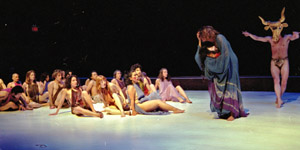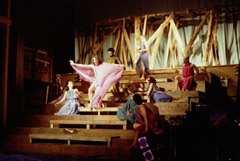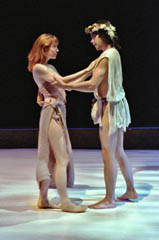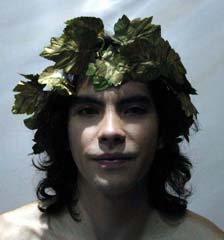
SCENE AND HEARD
by Randy Gener
 |
| Agave (Onni Johnson) weeps for the death of her son, Pentheus, as the people of Thebes and Dionysus, transformed into a bull, look on. |
"Dionysus Filius Dei"
Written and directed by Ellen Stewart
Performed by The Great Jones Repertory La MaMa E.T.C. Annex Theater
74A East Fourth Street New York, NY 10003
Box Office (212) 475-7710
www.lamama.org
Running June 15 to June 30
Run--don't walk--to see Ellen Stewart's breathtaking revival of "Dionysus Filius Dei." This is her most astonishing spectacle since "Mythos Oedipus."
Last seen at La MaMa in 1989, "Dionysus Filius Dei," offers those who are unfamiliar with Stewart's pioneering work a splendid crash course in her trademark ritualistic style. And for those who think they already know everything there is to know about the myth of Dionysus, this new revival, sensuous 60-minute piece that sung mostly in guttural voice and archaic Greek tongue, will prove to be a revelation.
 |
| Dionysus (Tom Lee) arrives in Thebes |
Anyone who has seen "The Bacchae" is familiar with the dismemberment rite associated with Dionysus, the destructive god of theatre, of the mask and impersonation. It is a story of sex and chaos, of orgiastic frenzy and sacrificial victims. Dionysus, the bastard god-son of Semele and Zeus, is an amorphous and transgendered spirit, and in the course of a drama in which his status as a deity is terribly blasphemed by the righteous Pentheus, Dionysus possesses Agave (Pentheus's mother) and the other bacchantes. In what is described as a sparagmos, the maenads tear Pentheus's body apart, limb from limb, and with the dismemberment completed, Agave, utterly mad and still possessed by the god, picks up her son's head and impales it on her wand, believing that it is her trophy, the head of a lion she has hunted.
An epic and eloquent dance-opera treatment of the myth of Dionysus, "Dionysus Filius Dei" doesn't stray very far from this legend tale. But what Stewart has done, quite masterfully, is to fill in the biographical blanks. She uncovers and dramatizes the evolutionary nature of Dionysus' divinity and history. Her production traces the story of Dionysus, starting from his birth and his childhood; it elucidates his homosexual love affair with the beautiful Ampelos; and the piece, which runs some 60 minutes long, retells Dionysus' globe-trotting travels to Attica, Aetolia, Amon and Egypt. It ends with his ascension to Mount Olympus.
 |
| Dionysus (Tom Lee) dances with the Queen of Egypt (Julia Martin) |
As in all of Stewart's spectacular dance-operas, "Dionysus Filius Dei" proceeds as a magisterial series of thrill-seeking dance numbers, now violent and pulse-pounding, now slow and elegant, now lusty and sweaty, often encapsulating narrative plots in quick strokes and deft movements. Chronologically each dance number outlines the Dionysian myth, and the intellectual pleasure of each number issues from Stewart's striking ability to collaborate with a diverse and multicultural repertory of dancers, choreographers and musicians and still bring off a cohesive, entertaining and illuminating evening.
Her dance operas are weakest when the storytelling is hamstrung a by-the-numbers plot, as in "Seven Against Thebes" which was saved by its frequently thrilling gladiatorial energy, or when the whole diversity of ethnic influences, don't exactly mesh into a humming whole as in the disappointing Kathakali dance opera "Draupadi." But when Stewart is in her element, as she is here, the effect is powerful and visceral. And she makes thrilling use of the cavernous Annex Theater-she is a poet of open space.
 |
| Youthful, charming, longhaired Tom Lee. Photo by: David Adams |
If anything, "Dionysus Filius Dei" drags and sags halfway into the evening, when Dionysus globetrots before reaching Thebes. Longhaired, youthful and charming as Tom Lee might be (he gives us gorgeously naked Dionysus with a bunch of golden grapes where his testicles might be), but he truly isn't a brilliant or imaginative enough dancer to be the focal center of Stewart's dance-opera. He's a beautiful blank. A more expressive Dionysus would probably be Chris Wild, who is simply an appetizing dish as Ampele, or Brian Nishii, the Japanese actor-dancer who appeared in "Mythos Oedipus." It's also highly surprising that Stewart's version mostly assigns a singular identity to Dionysus; the piece never does dramatically incorporate his changeable nature, the fact that Dionysus assumed many shapes, was frequently effeminate, and assumed a host of identities.
The result, therefore, is an episodic narrative that doesn't exactly climax into a shattering Dionysian tragedy. But then again Stewart has always been interested in the pageantry of Greek myths, an approach that bypasses realism and speaks directly to the emotions. There is something inexplicably seductive and colorfully expansive about her theatrical rendering of this timeless story, and it is that mysterious bighearted quality that makes every new production by Ellen Stewart, no matter what its eccentricities, always a sight to behold. [Gener]
 |
| Randy Gener |
Randy Gener is critic-at-large and a founding writer of The New York Theatre Wire. He also writes for The New York Times, The Star Ledger and American Theatre Magazine. His email is rndygener@aol.com.

| home | reviews |cue-to-cue |
discounts | welcome |
| museums | recordings |coupons |
classified |